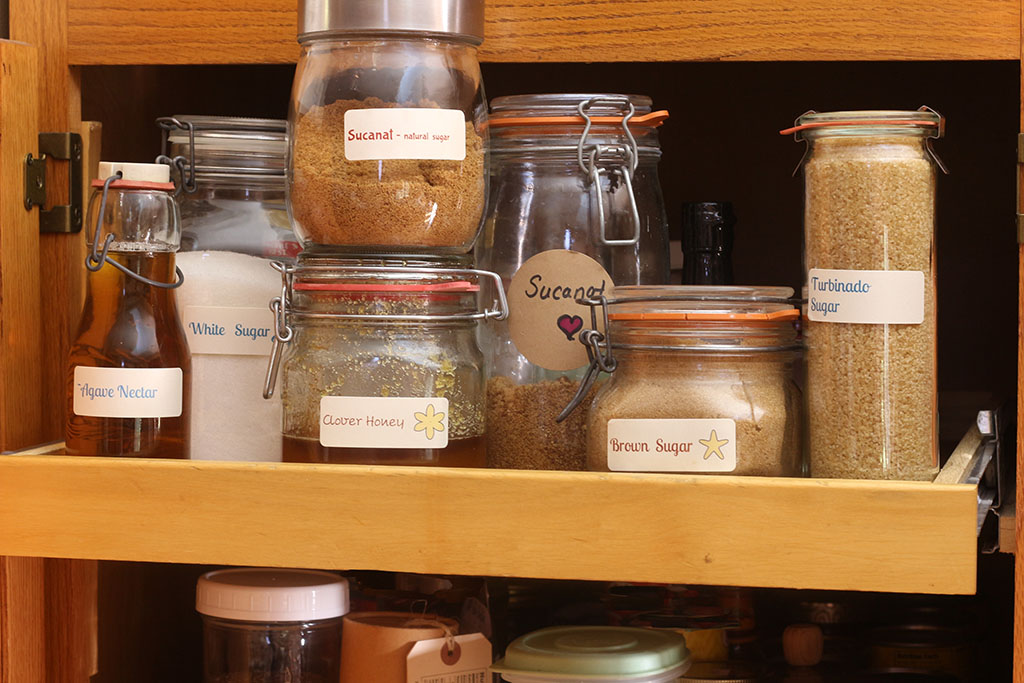
What Kind of Sugars Can I Use in Kombucha?

When you’re brewing kombucha, you need to feed the microbes so they can make probiotics. Sugar is the fuel source for these hungry critters. Always remember that the sugar is for those little microbes and not for you. They consume the sugar and then make probiotics and naturally occurring carbonation through the process of fermentation. It’s kind of a cool process how these little minions work to give you health benefits and a bubbly drink. Kombucha is an amazing drink!

Kombucha – What Sugars Can I Use?

 White Sugar: This is the most common sugar to use. It seems to work well and gives the best flavor.
White Sugar: This is the most common sugar to use. It seems to work well and gives the best flavor. Brown Sugar: The finished product was very pleasant! I really enjoyed the flavor of this particular brew. Ferments the same as regular sugar. Has a slightly "darker" but lovely flavor. Works just as well as white or cane sugar and has a slightly richer taste.
Brown Sugar: The finished product was very pleasant! I really enjoyed the flavor of this particular brew. Ferments the same as regular sugar. Has a slightly "darker" but lovely flavor. Works just as well as white or cane sugar and has a slightly richer taste. Turbinado Sugar: This worked as well as white and brown sugar, and I really liked the flavor. Turbinado undergoes very little processing. It has a slight molasses taste.
Turbinado Sugar: This worked as well as white and brown sugar, and I really liked the flavor. Turbinado undergoes very little processing. It has a slight molasses taste. Agave: This gives a nice mild flavor. Not overly sweet (if fermented fully) and not overly tart either. I enjoy this one a lot even though we don't use agave for regular cooking or baking. However, one downside is that is very expensive.
Agave: This gives a nice mild flavor. Not overly sweet (if fermented fully) and not overly tart either. I enjoy this one a lot even though we don't use agave for regular cooking or baking. However, one downside is that is very expensive. Honey and Raw Honey: Both work great! See my blog post about making Jun Kombucha. I use mostly green tea with honey to provide a light, refreshing flavor. It does tend to ferment faster so keep an eye on it. If you second ferment, make sure that your first ferment isn't too sweet or your batch could have a slightly higher alcohol content. The honey tends to provide more texture and yeast strings so you may want to strain before drinking or second fermenting, but it isn't necessary. Side note: Your SCOBYS will be lighter in color as a result of the lighter ingredients.
Honey and Raw Honey: Both work great! See my blog post about making Jun Kombucha. I use mostly green tea with honey to provide a light, refreshing flavor. It does tend to ferment faster so keep an eye on it. If you second ferment, make sure that your first ferment isn't too sweet or your batch could have a slightly higher alcohol content. The honey tends to provide more texture and yeast strings so you may want to strain before drinking or second fermenting, but it isn't necessary. Side note: Your SCOBYS will be lighter in color as a result of the lighter ingredients. Sucanat: Works about the same as turbinado but provides a deeper, slightly more molasses flavor which I don't care for as much as some of the other sugars.
Sucanat: Works about the same as turbinado but provides a deeper, slightly more molasses flavor which I don't care for as much as some of the other sugars. Cassava: This seemed to work just fine in the beginning! I don't have much history or information on cassava syrup, but I saw it so I decided to try it out. Has a mild flavor much like a white or cane sugar brew. It worked well overall and the flavor was mild. I did add about 1/4 cup more cassava syrup than I would with regular sugar. So for a three quart brew, I added 1 and 1/4 cups of cassava syrup.
Cassava: This seemed to work just fine in the beginning! I don't have much history or information on cassava syrup, but I saw it so I decided to try it out. Has a mild flavor much like a white or cane sugar brew. It worked well overall and the flavor was mild. I did add about 1/4 cup more cassava syrup than I would with regular sugar. So for a three quart brew, I added 1 and 1/4 cups of cassava syrup. Brown Rice Syrup: Works similar to agave. Has a nice flavor as well. I added 1/4 cup more syrup than I would have sugar as it has a lower sugar content than the rest. So, I added 1 and 1/4 cups of brown rice syrup to three quarts of water along with three to five tea bags. This brew can have a more cloudy appearance depending on the brand of brown rice syrup you use. When I used the Eco Farms brand, it was much more cloudy and had more sediment, perhaps because the rice syrup wasn't filtered but it was also fizzier!
Brown Rice Syrup: Works similar to agave. Has a nice flavor as well. I added 1/4 cup more syrup than I would have sugar as it has a lower sugar content than the rest. So, I added 1 and 1/4 cups of brown rice syrup to three quarts of water along with three to five tea bags. This brew can have a more cloudy appearance depending on the brand of brown rice syrup you use. When I used the Eco Farms brand, it was much more cloudy and had more sediment, perhaps because the rice syrup wasn't filtered but it was also fizzier! Maple Syrup: Maple syrup seemed to do really well! However, it does change the flavor quite a bit. I wasn't the biggest fan of the taste of this brew. It wasn't bad. It just tasted similar to a brew made with rooibos tea.
Maple Syrup: Maple syrup seemed to do really well! However, it does change the flavor quite a bit. I wasn't the biggest fan of the taste of this brew. It wasn't bad. It just tasted similar to a brew made with rooibos tea. Date Syrup: Date syrup produces a more purple-hued kombucha. It does work. but after two batches, I decided this wasn't for me. It was done WAY too quickly and was overly sour within just a few days. And to me, it had more of an unpleasant, alcoholic taste.
Date Syrup: Date syrup produces a more purple-hued kombucha. It does work. but after two batches, I decided this wasn't for me. It was done WAY too quickly and was overly sour within just a few days. And to me, it had more of an unpleasant, alcoholic taste. Coconut Sugar: We've had a lot of people have difficulty when using coconut sugar over long periods of time. We aren't sure if this is based on a particular brand of coconut sugar, or if it is because coconut is naturally antimicrobial, or because coconut sugar has a lower glycemic index. It seems to work for about four to six weeks and then something happens. The brew will eventually become weak and your SCOBY will mold (which is very rare without a major imbalance in kombucha brewing). If you wish to use this sugar, keep this in mind and always have a spare SCOBY and starter tea on hand.
Coconut Sugar: We've had a lot of people have difficulty when using coconut sugar over long periods of time. We aren't sure if this is based on a particular brand of coconut sugar, or if it is because coconut is naturally antimicrobial, or because coconut sugar has a lower glycemic index. It seems to work for about four to six weeks and then something happens. The brew will eventually become weak and your SCOBY will mold (which is very rare without a major imbalance in kombucha brewing). If you wish to use this sugar, keep this in mind and always have a spare SCOBY and starter tea on hand. Coconut Syrup: For some reason, this produces a more fizzy first ferment!. It worked well overall and finishes a day or two early. However, we had the same issues with coconut syrup that we had with coconut sugar. It works for about four to six weeks and then starts to slowly weaken.
Coconut Syrup: For some reason, this produces a more fizzy first ferment!. It worked well overall and finishes a day or two early. However, we had the same issues with coconut syrup that we had with coconut sugar. It works for about four to six weeks and then starts to slowly weaken. Black Strap Molasses: This brew tends to be done more quickly than the others (usually around Day Five), produces a much darker, deep flavor, and also a very dark SCOBY/brew as a result of the color of the molasses. This was my least favorite of all the brews that worked out. It is so dark it looks scary, hehe, but it does work with kombucha and provides a deep flavor. However, I will add that this particular brew wasn't very appealing to me. It was very, very strong and had a lot of sediment at the bottom. After a few batches, it had almost triple the sediment/yeast strings than a normal brew.
Black Strap Molasses: This brew tends to be done more quickly than the others (usually around Day Five), produces a much darker, deep flavor, and also a very dark SCOBY/brew as a result of the color of the molasses. This was my least favorite of all the brews that worked out. It is so dark it looks scary, hehe, but it does work with kombucha and provides a deep flavor. However, I will add that this particular brew wasn't very appealing to me. It was very, very strong and had a lot of sediment at the bottom. After a few batches, it had almost triple the sediment/yeast strings than a normal brew. Stevia or Non Caloric Sweeteners: Non-caloric sweeteners will not work for kombucha. Since there is no sugar in stevia the microbes will not have anything to make probiotics with. You need sugar in the brew to feed the microbes and without it they will starve and die.
Stevia or Non Caloric Sweeteners: Non-caloric sweeteners will not work for kombucha. Since there is no sugar in stevia the microbes will not have anything to make probiotics with. You need sugar in the brew to feed the microbes and without it they will starve and die.Are you on the list?
Sign up today and I'll send you my free Getting Started Guide!
Each week I'll send you updates, tips, recipes, and more! You might even be a winner of my weekly giveaway! (starter cultures, memberships, and more!)
Come be a part of my cultured food family!


